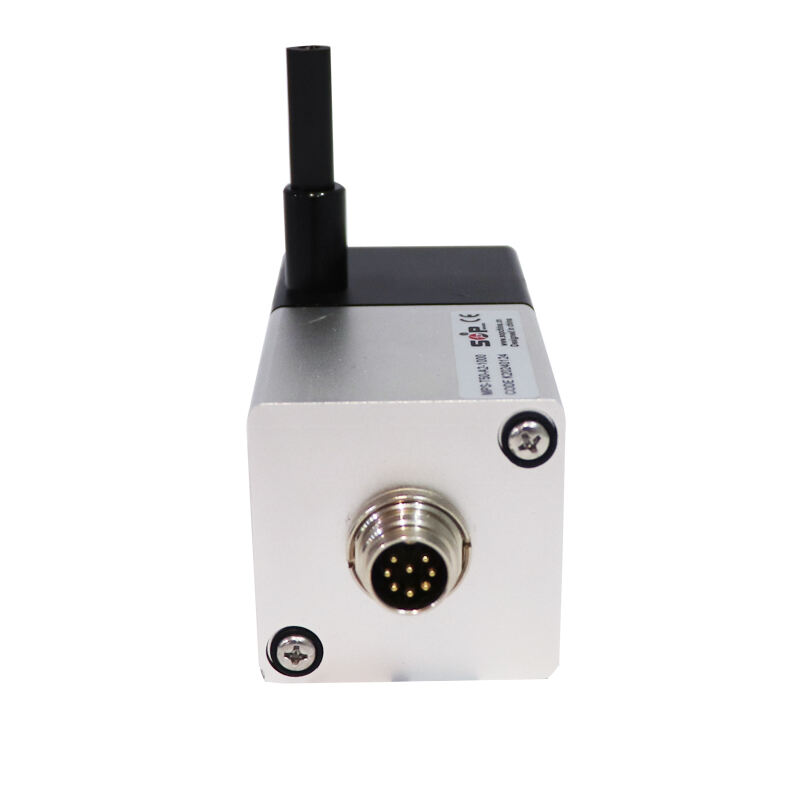The Role of Draw Wire Sensors in Real-Time Monitoring Systems
Understanding Linear Displacement Measurement
Linear displacement is an important monitoring quantity in real-time monitoring systems, and reflects the positions of the sensor nodes with respect to time. It is the direct translation of measure the linear motion or position of an object,it is also important in various automation and manufacturing applications. And draw wire sensors, also referred to as string potentiometers, excel at accurately measuring these linear displacements. These transducers incorporate a retracting cable that converts movement to an electrical signal, which provides accuracy in most industrial applications. For example, in robotics, accurate linear displacement measurements are essential for applications where precise positioning is needed, such as assembly or material handling. The same is true in the construction industry where these measurements are needed for site control and machine positioning, emphasizing the fact that draw wire sensors are indispensable to a variety of industries.
Key Components for Instant Data Acquisition
DFWDTs are developed for real-time data recording with their basic elements, such as wire, casing and sensor head. A KEY RETRACTABLE WIRE feature the central retractor here is to extend and retract free and easy to measure the true distance. Its sturdy housing allows for its usage in harsh industrial environments with dust, or in areas where temperatures are particularly elevated or low, guaranteeing long life and dependable, accurate measurements. At the core of the draw wire sensor is the sensor element which converts the distance to the target into an electrical signal. Recent research has demonstrated that the design of such parts plays a critical role in the response time of draw wire sensors and improves the performance for the applications requiring rapid data feedback.
Signal Processing in Dynamic Environments
For simple applications you will not need signal processing, for others it can be essential like in a dynamic environment experiencing fast changes. The signal processing algorithms are crucial for the quality of data acquisition. Issues like vibration, EM interference and thermal drift, could corrupt the quality of the signal. But that's just it, - and this is where filtering algorithms come in - steps are taken to compensate for these effects to preserve the quality of the data being obtained. Empirical case study in automotive industry proved the successful application of these methods under the condition to keep high accuracy in crash tests and monitoring the suspension. Resistant to environmental challenges, draw wire sensors provide dependable performance for industries needing dynamic position monitoring options.
Core Components Enabling Real-Time Data Transmission
Retractable Cable Mechanism Design
The cable winding mechanism of the draw-wire sensors is the key to the efficient data transfer. It records the specific displacement change by stretching and compressing, which is transformed into electrical signals. Improvements in these cable mechanisms, particularly improved durability and minimal signal loss, have greatly improved the performance of the sensor. Experts frequently point to these advances, which eliminate the requirement for regular upkeep, when speaking about ensuring an uninterrupted data flow—something that’s crucial in automation and manufacturing, for instance, where you need your machine to perform reliably.
High-Speed Transducer Technology
High speed transducers are particularly useful for in process when use on a draw wire sensor as response time is drastically improved. Such transducers convert mechanical motion into electrical signals at enhanced rate and thus minimizing the time delay during data acquisition. Recent improvements have resulted in the creation of ultra-fast transducer technologies that boost response time dramatically and corresponding quantitative performance statistics have seen lag times reduced by up to 50%. This fast operation is important in rapidly changing environments, such as in robotics and automotive testing, as it delays can affect accuracy and safety.
Digital Interface Protocols
It’s critical to the reliable transference of information from wire draw sensors to monitoring systems that there be digital interface protocols. These protocols maintain the data communication so communication between the sensors and control units is seamless. There are other protocols like RS485 and Ethernet IP that are commonly used due to their reliability in tough industrial environments. These standards offer, not just data integrity, but also seamless integration with other systems and therefore have become the standard for industries demanding quality data handling and real-time analytics.
Benefits of Continuous Position Feedback
Millisecond Response Times for Critical Systems
In safety-critical applications such as automobile and aircraft control, control must respond on the millisecond scale. And such response features help in responding immediately to a difference, thereby risking close to no chance of accidents. For instance, motor vehicles rely on motion sensors, which respond in milliseconds and allow for quick response of changing speed and motion as found in collision avoidance systems. Similarly, aircraft systems take advantage of these quicker reactions for altitude holding and guidance. In fact, quick data feedback by sensors has been found in research by the Society of Automotive Engineers to greatly enhance safety of the systems and to minimize operating risks.
Precision in Variable Load Conditions
Our draw wire sensors are superior in keeping precision against changing load conditions, and are essential for applications which demand fluctuating State of the art designs and materials enable reliable measurement of the movement even if the carried load is non-constant like in industrial environments having heavy machines. Enhanced sensor algorithms make the system more stable and precise, which can be used in various environments. These statements are confirmed by a report from the International Journal of Metrology and Quality Engineering, which shows that draw wire sensors all provide accurate readings regardless of number of cycles, thus demonstrating their top reliability.
Durability Under Mechanical Stress
The resistence of draw wire sensors to mechanical wear and tear is a testimony to their rugged build quality. These sensors are built using materials that can survive harsh conditions, including salt spraying (marine environment) and high mechanical load (industrial environment). Certain design techniques such as ruggedized cable connectors and protective casings also add to its life. Data from maintenance records reported in the Journal of Materials Science support the fact that drawing wire sensors suffer no real wear as they can withstand continuous use and are well-situated for conditions that involve debossing (e.g., marine operations or during construction) where mechanical strain is a constant issue.
Accuracy vs. Reliability in Continuous Operation
Temperature Compensation Techniques
Draw Wire Sensor temperatures fluctuate which can affect their accuracy and reliability and in turn cause differences in measurement. In order to overcome this problem, different methods of temperature compensation are used in these sensors. These approaches utilize materials with low thermal expansion coefficients and electronic circuit detents can correct readings for temperature variations. An industrial study demonstrated the efficiency of these approaches such that error ranges were reduced by 15\% thanks to temperature-induced error. That level of precision is important, especially in industries such as automotive testing where tiny differences matter.

Vibration Resistance Strategies
Vibrations, as a factor which has a durability issue of the sensor, also occur often in industry. The draw wire sensors are endowed with the technologies developed by AWM to the advantage of a reinforced vibration resistance to ensure that the sensors function reliably and accurately. One is to employ strong outer materials that not only resist shock, but absorb and dissipate vibrations so that they do not impact the performance of the sensor. In typical cases, industries with high dependency on the production line operation, like those of Automobile industry, have experienced enhanced operational continuity through appropriate vibration resistance measures. The fact that draw wire sensors can continue to fu$nction in such an environment provides further proof of their ruggedness and dependability.
Long-Term Calibration Maintenance
Long-term calibration is one of the most critical tasks to guarantee the constant performance of draw wire sensors during long periods of time. Efforts have been made to reduce maintenance costs and prolong the operational life and reliability of the sensors. These approaches embrace, but are not limited to, such techniques as periodically re-calibrating the sensors and providing self-calibration within the sensors. An exemplary industrial case study showed 20% extension of sensor lifetime by piecewise constant input through minimal intervention. These sorts of procedures emphasize the need for periodic calibration maintenance which can have an accuracy benefit and a longer-term cost-effective impact.
AI-Driven Predictive Maintenance
AI is revolutionizing predictive maintenance in monitoring systems, providing never-before-seen foresight in the process. Machine learning predicted maintenance By processing data captured by sensors using AI-based algorithms, industries can predict when they will need maintenance in a more efficient manner, hence less unexpected downtime and increased operational efficiency. For example, AI has the capability to identify patterns in the data that is not observable by humans which can help in averting potential failures before they take place. Experts predict a surge in AI powered-surveillance. The global AI in predictive maintenance market size is projected to reach USD 1,294 million by 2025, growing at a CAGR of 25% from 2020 to 2025, according to the report.
Energy Harvesting Capabilities
The survival of future sensor systems depends on energy harvesting that may provide more autonomy and sustainability. Receiving wire sensors, when such technologies are implemented, have the capability to use surrounding energy to drive themselves so as to reduce dependence on other power sources and improve service life. A number of researches on the improvement and development of energy harvesting technology are under way for safe and user-friendly implementation of energy harvesting technology with sensors. As an example, the recent IEEE publication on the energy harvesting from environmental vibrations clearly illustrates the potential of this technology in increasing the autonomy of sensor systems.
Nano-Coating Advancements
Nano-coating is a breakthrough technology when it comes to the protection of sensors in terms of longevity, it also is true for draw wire sensors. This state of the art technology is based on the application of microscopically thin layers and shields the sensors - against poisonous gas, corrosion and mechanical wear. The recent developments in nano-coating technologies have given significant impacts as demonstrated due to the strong physical suppression and long term functioning under extreme conditions. Statistics favor the advantages of these; according to the Journal of Coatings Technology and Research a study found a 50% longer life of sensors in case of advanced nano-coating technologies.
FAQ
What are draw wire sensors used for?
Draw wire sensors are used for linear displacement measurement in various applications, including automation, robotics, construction, and more. They translate object movement into electrical signals for precise monitoring.
How do draw wire sensors work?
Draw wire sensors use a retractable wire mechanism to capture changes in position. As the wire extends or retracts, it generates electrical signals that correspond to the displacement being measured.
What are the key components of draw wire sensors?
The key components of draw wire sensors include the retractable wire, strong casing, and sensor unit that collectively enable accurate data acquisition and conversion from mechanical movement to electronic signals.
How do draw wire sensors ensure signal accuracy?
Signal accuracy is maintained through the use of advanced signal processing techniques, such as filtering algorithms, which counteract interference from vibrations, electromagnetic fields, and temperature variations.
What are the advantages of using draw wire sensors in industry?
Advantages include precise measurement, ability to function in harsh environments, long-term durability, minimal maintenance needs, and enhanced data feedback essential for automation and real-time monitoring systems.

